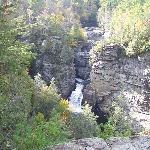Touring the Mountain region of North Carolina from Brenda on Vimeo.
We want to tell you about the Mountain region of North Carolina and what you can do. Come visit Grandfather Mountain, Linville Caverns Blowing Rock/Boone, Asheville, Biltmore House and the Waynesville area – Cherokee Indian Reservation. Go for a hike and see animals like whitetail deer, bear, squirrel and birds. Go snow skiing in the winter! See lots of waterfalls.
Outdoor recreation and outdoor adventures are seemingly endless in the Western North Carolina mountains, the outdoor playground of the Southeast. Visitors enjoy whitewater rafing, biking and hiking and experiencing the highest peaks in the entire Eastern U.S. Grandfather Mountain is important for it’s biodiversity and it is named because it looks like a grandfather sleeping. There is the mile high swinging bridge to experience while there and it is 5,946 feet elevation at Grandfather Mountain.
Mount Mitchell is the tallest peak in the Eastern United States at well over a mile high. At an elevation of 6,684 feet (2,037 metres). In Asheville you can visit the largest private owned home Biltmore Estates. You can shop at outdoor markets and go to parks. You can go to the folk art center and learn crafts. You can go to the Botanical Gardens. You can visit Tweestie Railroad and ride an old fashion train. You can travel to Linville Caverns and go underground and see waterfalls. The mountains also are a place to golf and horseback ride. In Boone you can see a play Horn in the West and in Cherokee you can see another about Cherokee life while visiting the Cherokee Indian Reservation where you can shop, fish and hike. We invite you to enjoy the many fun and relaxing things to do such as the Oconaluftee Indian Village, “Unto These Hills” Outdoor Drama, Museum of the Cherokee Indians and Qualla Arts and Crafts Mutual.
http://www.youtube.com/watch?feature=player_embedded&v=2foW5p0ytxo
As you can see many adventur es await you in the North Carolina Mountains.
es await you in the North Carolina Mountains.





